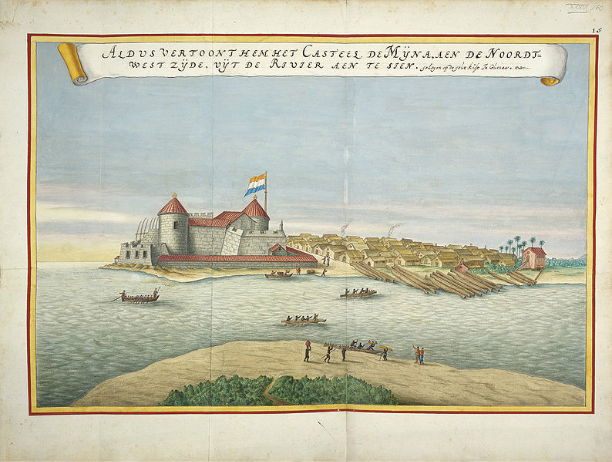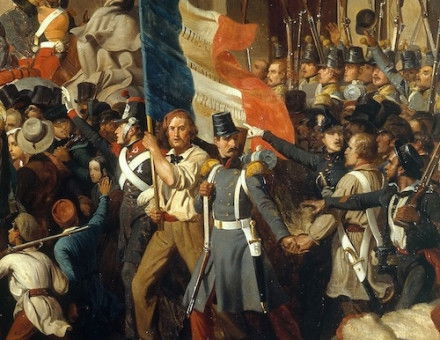Ghana's Slave Castles
Ghana's slaving past, long regarded as too sensitive to even discuss, is now becoming a lively issue. A group of Ghanaians, led by lawyers and tribal chiefs, have convened an Africa-wide meeting to seek 'retribution and compensation for the crime of slavery’.
 Using the example of recent successes for Jews whose property was confiscated by the Nazis, they cite the misery of millions of African slaves and their descendants, and have called on Western bankers and governments to compensate them by at least lifting the burden of Third World debt. But, as more is discovered about the realities of the tragic trade, some Ghanaians are beginning to wonder how much of the blame for the centuries of slavery should be shared by Africans themselves.
Using the example of recent successes for Jews whose property was confiscated by the Nazis, they cite the misery of millions of African slaves and their descendants, and have called on Western bankers and governments to compensate them by at least lifting the burden of Third World debt. But, as more is discovered about the realities of the tragic trade, some Ghanaians are beginning to wonder how much of the blame for the centuries of slavery should be shared by Africans themselves.
Elmina Castle, the most famous of Ghana's slaving castles, sits astride a rocky promontory at one end of a palm-fringed bay on the coast of Ghana. It was built by the Portuguese before Columbus discovered America. Indeed, it is thought that Columbus may himself have sailed as a deck-hand on one of the ships in the convoy that carried the building materials for the new castle on what was then known as the Guinea coast.
This great pile of white-washed walls and battlements, dating from 1482, is the oldest European building in tropical Africa. It is one of about thirty surviving castles, forts and trading posts that still bear witness to four centuries of the presence of Europeans trading in gold, ivory - and slaves.
At the height of the slave trade there were over sixty such strongholds crammed together on a stretch of coast less than 300 miles long. The remains of about thirty can still be seen today. They are one of Ghana's most distinctive features, a unique collective historical monument.
Elmina is one of the castles that has been rescued from crumbling into the sea, while others, built by the Dutch, Prussians, French and British, are variously used as police stations, prisons, post offices, lighthouses, schools and official residences.
Clearly visible from the ramparts of Elmina is the outline of another great castle in the distance, Cape Coast, built by the Swedes in 1653. Some of these competitive fortresses were almost within cannon-shot of each other. Many changed hands and, by the end of the nineteenth century, after the abolition of slavery, the British had either conquered or bought out the trading interests of all the other European nations and set up the Gold Coast colony. The Danish-built Fort Osu, dating from 1661, became the British seat of colonial government in 1873, and is today the official home of the president of Ghana.
Lust for gold drew the Portuguese to this part of West Africa. Alluvial deposits and mines in the hinterland became an important source of raw material for the royal mints in Lisbon. Slaves were needed to work the mines and at first the Portuguese imported men from other areas of Africa. But, in the 16th century they began using slaves caught on the Gold Coast. As the historian Albert van Dantzig points out: 'Nearly all the forts were built with the consent, sometimes at the urgent request, of the local chiefs and people. The forts were built to keep other European traders away and it was on the side of the sea that they had their strongest defence.’
Elmina’s dominance of the Gold Coast lasted until 1637 when the Dutch drove out the Portuguese and expanded their own slave trade. They greatly added to the castle, using bricks and timber brought from Amsterdam, creating a larger courtyard overlooked by a new range of rooms. They turned the late medieval Portuguese church in the courtyard into a slave market.
The merchants and administrators, adherents of the Dutch Reformed Church, had refused to worship where Catholics had prayed before, and built their own chapel in another part of the castle.
Cape Coast Castle and Elmina, both well-preserved and the centre of a burgeoning tourist trade, offer another surprise – streets lined with European houses, public buildings and churches dating from the early nineteenth century, and in some cases from the eighteenth century. But many of the surviving houses are almost derelict, and a wall of one fine merchant's house in Elmina, decorated with arches and columns, collapsed the night before I went to see it. However, like the castles, historic buildings like these are beginning to attract a trickle of funds to save them. US Aid and Conservation International are helping to fund the restoration of the British Governor's mansion in Cape Coast, and at Elmina the Americans are supporting the 'Save Elmina Association', which offers maintenance grants to owners of historic properties. Excavations by James Anquandah, professor of archaeology at Ghana University, have revealed the influence of 'castle culture' on the towns in the shadow of their walls from the earliest times. He reports: 'We found pencils and slates, even ink bottles still filled with ink, confirming the existence of schools set up by European missionaries. Metal working was one of many trades taught by the Europeans; we found large quantities of brass objects, marking the beginnings of a jewellery trade.'
In Cape Coast Castle, the Smithsonian Institute helped set up a Museum of Slaving which now caters to an increasing number of African Americans - the descendants of slaves who arrive in search of their roots. Visitors weep as they come out of the dungeons at Cape Coast Castle, having seen where hundreds of slaves were kept in gloom and damp before the Atlantic crossing to America or the Caribbean islands. The guides take them along a tunnel to what was known as 'the gate of no return'. A narrow slit in the castle wall, only wide enough for one at a time, opened onto the sea, the waiting ships, and another ordeal. Another revelation is the process by which the slaves were acquired. Recent research by Dr Akosua Perbi of the University of Ghana has shown a substantial African involvement in the trade. Typically, after an inter-tribal war, the prisoners taken by the winning side were sold to the castles. Then there were traders arriving at the Gold Coast from the north with slaves. Individuals also kidnapped people to sell them into slavery. Dr Perbi's research has revealed that some African traders supplied as many as 5,000 slaves per year to European merchants. Several African-Americans who have decided to settle in their ancestral continent live near the castles and take an active interest in their preservation. When tourist authorities opened cafes and bars inside the castles and started to clean and whitewash the dungeons, African-Americans staged a sit-in in protest at what they saw as a desecration of a shrine to the tragic crime of slavery. The authorities backed down: the cafes were moved and the paint pots put away.




